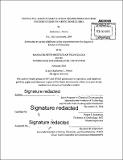Testing the ancient marine redox record from oxygenic photosynthesis to photic zone euxina
Author(s)
French, Katherine L. (Katherine Louise)
DownloadFull printable version (25.19Mb)
Other Contributors
Woods Hole Oceanographic Institution.
Advisor
Roger E. Summons.
Terms of use
Metadata
Show full item recordAbstract
Tracing the evolution of Earth's redox history is one of the great challenges of geobiology and geochemistry. The accumulation of photosynthetically derived oxygen transformed the redox state of Earth's surface environments, setting the stage for the subsequent evolution of complex life. However, the timing of the advent of oxygenic photosynthesis relative to the Great Oxidation Event (GOE; -2.4 Ga) is poorly constrained. After the deep ocean became oxygenated in the early Phanerozoic, hydrogen sulfide, which is toxic to most aerobes, may have transiently accumulated in the marine photic zone (i.e. photic zone euxinia; PZE) during mass extinctions and oceanic anoxic events. Here, the molecular fossil evidence for oxygenic photosynthesis and eukaryotes is reevaluated, where the results imply that currently existing lipid biomarkers are contaminants. Next, the stratigraphic distribution of green and purple sulfur bacteria biomarkers through geologic time is evaluated to test whether these compounds reflect a water column sulfide signal, which is implicit in their utility as PZE paleoredox proxies. Results from a modern case study underscore the need to consider allochthonous and microbial mat sources and the role of basin restriction as alternative explanations for these biomarkers in the geologic record, in addition to an autochthonous planktonic source.
Description
Thesis: Ph. D., Joint Program in Chemical Oceanography (Massachusetts Institute of Technology, Department of Earth, Atmospheric, and Planetary Sciences; and the Woods Hole Oceanographic Institution), 2015. Cataloged from PDF version of thesis. Includes bibliographical references.
Date issued
2015Department
Joint Program in Chemical Oceanography; Woods Hole Oceanographic Institution; Massachusetts Institute of Technology. Department of Earth, Atmospheric, and Planetary SciencesPublisher
Massachusetts Institute of Technology
Keywords
Joint Program in Chemical Oceanography., Earth, Atmospheric, and Planetary Sciences., Woods Hole Oceanographic Institution.